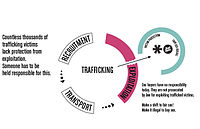
Photo from wikipedia
Sex trafficking of children and youth is receiving significant attention from practitioners, researchers, and policymakers. Recognition that sex trafficking constitutes a form of child abuse has increased; however, there is… Click to show full abstract
Sex trafficking of children and youth is receiving significant attention from practitioners, researchers, and policymakers. Recognition that sex trafficking constitutes a form of child abuse has increased; however, there is still a need for a theoretical framework that provides direction on how best to intervene and conduct research into this phenomenon. In this article, we present a traumagenic social ecological framework of child sex trafficking that examines perceived social norms, societal and environmental factors, extended and intimate relationships, and personal characteristics that influence the ecological setting in which the child is embedded. Utilizing a four-tier approach, our framework focuses on how factors at each level interact and contribute to youths’ vulnerability for sex trafficking through mechanisms including social norms. This allows us to move beyond individualistic explanations of why sex trafficking occurs and consider more complex relationships. This framework is also useful to identify and group intervention strategies on the basis of social ecological level, as each level can be thought of as both a level of influence and a key point for prevention. In addition, interventions that have an impact on all levels of the social ecological framework are encouraged in order to successfully prevent child sex trafficking.
Journal Title: Child and Adolescent Social Work Journal
Year Published: 2018
Link to full text (if available)
Share on Social Media: Sign Up to like & get
recommendations!